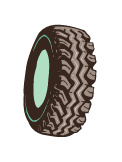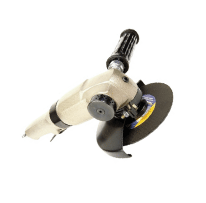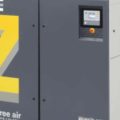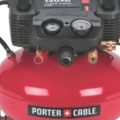Hey! This site is reader-supported and we earn commissions if you purchase products from retailers after clicking on a link from our site.
Compressed air is all around us and you may not even be aware of it! This page provides a broad range of information about what compressed air is.
The more you understand about what compressed air is and the use of compressed air as an energy source, the better you will be at integrating it into your workshop or plant.
Table of Contents
- What Does Compressed Air Mean?
- Compressed Air Information
- Compressed Air Theory
- Theoretical Compression Types
- FAQs (Frequently Asked Questions)
- Further Reading
What Does Compressed Air Mean?
The molecules of air occupy a certain volume in free space, when compressed, the molecules come closer together meaning they are occupying less space. As the number of molecules of air increases in any given volume, the mass of air also increases.
As the mass of air in any given volume increases, so does the density. And finally, with the density increasing, the pressure of the air increases and therefore becomes compressed air.
Compressed Air Information
Compressed air is one of the three commonly available energy sources for the manufacturing industry:
-Compressed Air Energy
– Hydraulic Energy
– Electrical Energy
Of these three, compressed air is the energy source of choice for doing much of our nation’s industrial work and there are good reasons for that.
Compressed air is an energy source that’s relatively easy to store, is non-flammable, is very powerful, and can generate high productions speeds in a variety of ways including air cylinders and air actuators. Compressed air is extremely versatile in the numbers of ways it can be used.

For example, compressed air can provide an air cushion upon which we drive our vehicles. The air inside the tire is “pumped” into the it with a manual bicycle type air compressor, or via the compressed air hose from the air compressor that’s located somewhere inside the local tire store or corner garage.
Remember when pumping air into your car tire at the gas station was free? Compressed air still is if you chose to use that hand compressor we all had at one time… the bicycle tire pump. But who wants to do that?

With compressed air, you can rough or fine finish the surface of a piece of woodwork, or smooth weldments in steel with an air sander or grinder. Compressed air is used everywhere.
Portable Compressed Air
Compressed air can be carried anywhere with an appropriate pressure vessel – sometimes called an air hog or air pig.
Compressed air helps people breathe underwater with portable SCUBA tanks, in an environment that is foreign and deadly to them.
And as mentioned earlier, compressed air is relatively safe in that it’s non-flammable. When you spill compressed air, it doesn’t make a mess!
Energy Conversion
Compressed air is able to do work because as you compress air you transform one form of energy into another form of energy which you then store for later use.
This stored energy, in the form of compressed air, is now at imbalance, in that you have an area of high pressure in a compressor tank surrounded by an area of lower pressure; our atmosphere.
Imbalance in Compressed Air
Mother Nature doesn’t like imbalance in her systems. If you have a container – an air tank, a receiver, an air-hog, or a plant air main filled with compressed air at 150 PSI or so, this bothers her. She wants that air to be back at a nice, comfortable, 14.7 PSI everywhere- that 14.7 PSI being the pressure of the atmosphere at sea level. And she wants high pressure gone right now!
That drive to achieve balance in nature – that is, to get the compressed air from an area of high pressure back to atmospheric pressure, means that when you open the valve on the tank or airline, air will move at almost the speed of sound, rushing from high to low pressure, to get back to normal atmospheric pressure.
By controlling this flow of air, and directing it into tools that in themselves can perform work, then you can extract the work energy from the compressed air energy as it decompresses back to atmospheric levels.
Over the years, we have learned how to use this high-to-low pressure flow of air to do work for us via specialty nozzles, air tools, air actuators, air motors, and so on. Compressed air really is a neat way to store and use energy.
Compressed Air Risk
Compressed air can be, and often is, worked with and on by persons without formal training. If that person isn’t skilled in using compressed air, it could result in injury or death to them or their colleagues, or cause damaged equipment. Be very careful! Compressed air can be dangerous.
If your application involves manufacturing or processing products that are flammable or explosive, compressed air actuators and air-operated directional control valves don’t create sparks.
Therefore, fire or explosion risk can be reduced to an acceptable level when using compressed air equipment in almost all flammable operations. Compressed air can be used in applications where other energy forms might blow you to kingdom come!
Air Instead Of Hydraulics
If the force you require for your application can be generated by an air compressor using appropriate air valves and actuators, then you would pick compressed air as your energy source over hydraulics simply because compressed air components, from the compressor through to tools, are less expensive.
Using hydraulic energy is more expensive in the generation of energy to do work, and in the cost of the components to use hydraulic force. If you don’t need the immense pressures and force that hydraulics can give you, it doesn’t make sense to pay for that capability. Use compressed air, instead.
And, when you get a hydraulic leak, that’s quite a visible phenomenon. A hydraulic oil leak generates issues with regards to safety as well, as high-pressure oil spraying from a small orifice can hurt someone. Whether a high-pressure leak or just a drip, hydraulic oil in the wrong place does create more than just a mess, but a significant slip hazard as well.
There’s also an increasing concern about the potential for environmental damage from hydraulic oil leaking onto and into where it’s not supposed to be.
A compressed air leak, albeit costly in wasted energy to compress that air in the first place, usually doesn’t create these same hazards.
Electricity As An Energy Source
Electricity use is often complex to employ, requiring a skill set many folks don’t have. Also, electricity can be quite dangerous.
An electrician told me once that you might get killed by being well-grounded and touching a 120 Volt AC power source. That same electrician said if you touch a 240-volt source, there’s no more might about it, you will die. Electrical work should be performed by a licensed electrician, and if you haven’t one on staff, that can get costly, which may be an issue for some businesses.
On the upside, in the urban world, electricity is ubiquitous – found almost everywhere.
Many industrial operations use a great deal of electricity in their operations, often in a control capacity or smaller manufacturing processes. However, electricity cannot economically generate the force that’s available from compressed air or hydraulic power. It compares poorly in both size of components and the strength of the force generated.
Ironically, it’s electricity that most often drives the industrial air compressor and the hydraulic power pack. But it is the compressed air from that compressor that provides the heavy lifting work in the typical manufacturing plant. And it’s the hydraulic system that provides huge amounts of force when that force is what’s called for.
Electricity has its place in the industrial world, as does hydraulic energy. Regardless, for my money, if compressed air can generate the force I need versus other energy sources, for the reasons outlined here, compressed air is the energy source that I would pick first.
Compressed Air Theory
The air we breathe has two major components which are Nitrogen and Oxygen. It is approximated that there is around 78% of nitrogen, 21% of oxygen, and 1% of other gases in atmospheric air.
Air is not a “perfect” gas but the presence of nitrogen and oxygen in major proportion makes it very close to a perfect or ideal gas. As you should already know, an ideal gas obeys a few laws which are:
- Boyle’s law (PV=K)
- Charles’ law (V/T=K)
And these can be combined to form a new law that is represented by:
PV/T = K
Where:
P = Pressure
V = Volume
T = Temperature
K = constant
But what does this combination mean? Well, let’s break down each law.
Boyle’s Law
Robert Boyle created the Boyle’s law in 1662. The law explains the relationship between pressure and volume. It indicates that pressure multiplied by volume will always equal a constant.
So what does Boyle’s law tell us? as the volume of space containing air reduces, pressure increases if the temperature stays the same. This, therefore, means, that we are able to increase the pressure of air by forcing it into a smaller space. (Sounds a lot like how an air compressor works right?!)
Charles’ Law
Jacques Charles created the Charles’ law in the 1780s. His law explains that a gas’ volume divided by its temperature equals a constant that is pressure. When you increase temperature, you therefore also proportionally increase volume to maintain the same pressure.
An increase in temperature causes the molecules in a gas to move away from one another which therefore increases the amount of space the gas takes up.
Combining Boyle’s and Charles’ Laws
The combination law explains to us what happens to air when it’s compressed into a smaller volume. When air is compressed, the pressure and temperature of the air increase, as the volume of the space containing air decreases.
By forcing air into a smaller space it becomes hotter and more pressurized. As the molecules in the air constantly try to spread apart to their natural distance pressure is produced.
Pascal’s Law
Another notable law to be aware of with compressed air is Pascal’s. It states:
When force is applied to a fluid in a closed vessel, it is transmitted equally in all directions.
Force is applied to the inside of the compressor tank with the compressor driving air into it, and that air pressure inside is pushing equally against the entire inside of the tank.
When a downstream air valve opens, since air is pushing equally in all areas, it will instantly blast out of the tank through the now open line, to pressurize the downstream air mains, racing towards the atmosphere and what nature calls balance; where air pressure is at the same level.
The compressed air wants to maintain pressure equally so it flows from high pressure to low until pressure is equalized.
Theoretical Compression Types
Now that I’ve provided you with a greater understanding of the theory behind compressing air, let’s look at the ways we can compress it. There are two ways to theoretically compress air and these air:
- Isothermal compression
- Adiabatic compression
Isothermal compression is as straightforward as it is a form of compression where heat stays the same. It does so, by removing the heat produced during compression at the same rate it’s created to keep the temperature constant. So in theory, the compressor must be designed so that the heat generated can be extracted at an equal rate.
Adiabatic compression, otherwise known as, isentropic compression, is the opposite of isothermal compression. All the heat generated by compressing air is not removed from the system and instead stays in the compressed air.
Both have real-world limitations that you must be conscious of. In isothermal compression, the air needs to be compressed slowly, the cylinder bore must be small and the system will require a high standard of cooling. This slowing of the whole system reduces efficiency.
In adiabatic compression, air that is too hot can be dangerous and potentially result in both system failure and safety issues. On top of this, extremely hot compressed air is not desirable for most applications.
FAQs (Frequently Asked Questions)
Compressed air contains, as you may have guessed, air! And as air is a gas mixture, air contains 78% nitrogen and 21% oxygen.
Compressed air is used as the transfer of energy in numerous industrial processes to power tools like air wrenches, drills, sandblasters, and much more. Not only this but, compressed air can be used to propel vehicles, operate cylinders in automation and atomize paint!
This will depend on the pressure of the air. The mass of one cubic foot of air at 14.7 psi (atmospheric pressure) is 0.0807 lbs. When compressed to 1000psi, a cubic foot of air will weigh just over 5 lbs.
During adiabatic compression, the volume of the air decreases which causes an increase in pressure. Due to the work-energy being converted into internal energy, the temperature, therefore, increases in adiabatic compression.
Further Reading
Rotary Vane Compressors Explained
Centrifugal Compressors Explained
Axial Flow Compressors Explained
Reciprocating Air Compressors Explained
Scroll Air Compressors Explained
How to use an Air Compressor – Guide to Operating Air Compressors
How To Calculate CFM of Air Compressors – Calculating CFM
How To Size An Air Compressor – What Size Compressor Do I Need?
If you have any questions regarding compressed air, please leave a comment below, with a photo if applicable, so that someone can help you!





